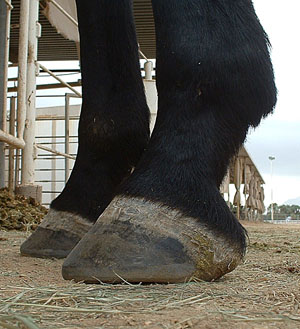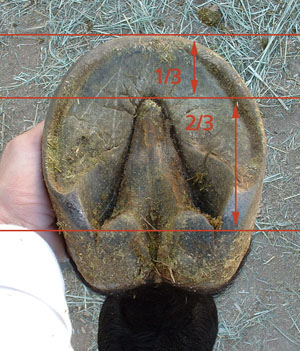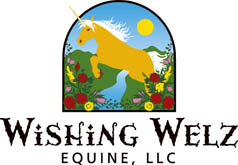
Trimming 1-2-3
by Yvonne Welz ©2007
Modern barefoot trimming is a relatively new science and art, with most of its practitioners having begun within this past decade. As techniques have been developed and practiced over years of trial and error, the similiarities between the emerging barefoot groups have actually increased. Even when trimmed from different backgrounds, perpectives and emphasis, a sound, healthy, captive horse's hoof begins to take on a very recognizable and structurally-strong hoof form.
Perhaps the most helpful "rule of thumb" comes to us from Dr. Robert Bowker. While his research is extensive, complicated, and frankly overwhelming in a very exciting way -- his recommendations for trimming are elegantly simple. He is not a trimmer -- he is a scientist -- but perhaps that's what gives his advice such clarity. He describes his recommendations as the "physiological trim" because it is based on his discoveries of how the hoof really works. It has 3 simple parts: 1) Heels Short; 2) Toes Short; 3) 1/3 - 2/3 frog proportions.
1) Heels Short
The heels must be short enough that the rear of the hoof (frog, bars, and bulbs) can take a major part in the weightbearing load. Frogs should be on the ground. The horse must be comfortable enough to land heel-first to develop correct structure in the back of the foot. A slightly heel-first contact activates the proprioreceptors (so the horse senses where his feet are!) in the heels, stimulates blood flow, and allows for shock absorption.

2) Toes Short
"Short toes are the best thing you can do to a foot." -- Dr. Robert Bowker
Toes should be shortened from the front of the hoof, rather than from underneath. Shortening the toes from underneath will remove too much needed sole material that cushions underneath the coffin bone. Toes should be "backed up" by rasping from the front, and rolling the edge using a mustang roll. The mustang roll reduces the "peripheral loading" on the hoof wall, which improves circulation inside the foot.
For horses with lots of excess toe or with pathology, x-rays can help determine how far to bring the toe back. Mark the apex of the frog before taking the x-rays. On the x-rays, measure 1/4 inch in front of the coffin bone tip, and drop a line to the ground - that is where to start the bevel.

3) 1/3 - 2/3 frog proportions
Work towards the goal of having the hoof proportions such that 2/3 of the length of the solar surface is frog, and only 1/3 is in front of the apex of the frog. If you have more than 1/3 in front of the apex, the toes are too long, and need to be shortened (backed up) over time.
No matter what your style or method of trimming, remembering these trimming 1-2-3's will help ensure success!
(March 2007)
©2007 by The Horse's Hoof. All rights reserved. No part of these publications may be reproduced by any means whatsoever without the written permission of the publisher and/or authors. The information contained within these articles is intended for educational purposes only, and not for diagnosing or medicinally prescribing in any way. Readers are cautioned to seek expert advice from a qualified health professional before pursuing any form of treatment on their animals. Opinions expressed herein are those of the authors and do not necessarily reflect those of the publisher.
The Horse's Hoof Website
Home - About Us - Horselover's
Corner - Articles - Barefoot
Performance - Barefoot Stories - Hoof
Gallery - Natural
Horse Care - EPSM
- The Horse's Hoof Clinics - Events
- Trimmers -
Pioneers - Friends
- Classified - Resources
- News - Links
To go shopping or subscribe to our magazine, please click here: The
Horse's Hoof Store
If you don't see a column to the left: To view the frames version of this site, please click here: TheHorsesHoof.com
The Horse's Hoof is a division of:

The Horse's Hoof
P.O. Box 1969
Queen Creek, AZ 85142
Phone (623) 935-1823
Message Phone: 1-623-935-1823
(Leave a message anytime.)
Email: editor @ TheHorsesHoof.com (delete spaces)